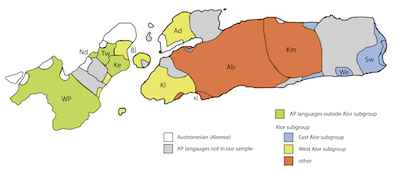Spatial Orientation in East Nusantara
The Austronesian languages are well-known for the prevalence of geocentric systems of spatial orientation which use geography rather than ego as a reference point—most notably the distinction between ‘seaward’ and ‘landward’ This basic system has deep antiquity and can be reconstructed for Proto-Austronesian.

 The MEaCoM project convenes a series of workshop bringing together key stakeholders including linguists, archivists, and software developers to develop a software requirements specification and associated use cases (or “user stories”) for a metadata and collection management tool. A beta version, dubbed laMeta, was released in March 2020 and is freely available for
The MEaCoM project convenes a series of workshop bringing together key stakeholders including linguists, archivists, and software developers to develop a software requirements specification and associated use cases (or “user stories”) for a metadata and collection management tool. A beta version, dubbed laMeta, was released in March 2020 and is freely available for  The Kaipumakani Project supports the development of a Mukurtu Hub for Hawai‘i and the Pacific, as part of Mukurtu Hubs & Spokes, an IMLS National Leadership Grant to Washington State University. This project will develop the next generation of the Mukurtu CMS and facilitate digital cultural heritage preservation in the Pacific. (http://kaipumakani.org)
The Kaipumakani Project supports the development of a Mukurtu Hub for Hawai‘i and the Pacific, as part of Mukurtu Hubs & Spokes, an IMLS National Leadership Grant to Washington State University. This project will develop the next generation of the Mukurtu CMS and facilitate digital cultural heritage preservation in the Pacific. (http://kaipumakani.org) The endangered languages crisis is widely acknowledged as one of the most pressing problems facing humanity today, posing moral, practical, and scientific issues of enormous proportions. The Catalogue of Endangered Languages (ELCat) represents the first fully reliable source dedicated to the endangered languages of the world. Founded in 2012, the Catalogue provides authoritative information on language status and vitality, informs users about the plight of endangered languages, and encourages efforts to slow the loss.
The endangered languages crisis is widely acknowledged as one of the most pressing problems facing humanity today, posing moral, practical, and scientific issues of enormous proportions. The Catalogue of Endangered Languages (ELCat) represents the first fully reliable source dedicated to the endangered languages of the world. Founded in 2012, the Catalogue provides authoritative information on language status and vitality, informs users about the plight of endangered languages, and encourages efforts to slow the loss. The Alaska Native Place Names Project collaborates with Indigenous communities across Alaska to consolidate Indigenous place name documentation and related linguistic, cultural and environmental knowledge.
The Alaska Native Place Names Project collaborates with Indigenous communities across Alaska to consolidate Indigenous place name documentation and related linguistic, cultural and environmental knowledge. Origins of the Alor-Pantar Languages</a> (2009-2016) is an NSF-funded project which seeks to unravel the linguistic prehistory of the non-Austronesian (Papuan) languages the of Alor-Pantar archipelago of southeastern Indonesia. This international project, conducted under the aegis of the European Science Foundation EuroBABEL programme, has vastly increased our knowledge of the previously under-documented Alor-Pantar language family. A volume of papers detailing the results of this project was published in 2014 (revised 2017) as
Origins of the Alor-Pantar Languages</a> (2009-2016) is an NSF-funded project which seeks to unravel the linguistic prehistory of the non-Austronesian (Papuan) languages the of Alor-Pantar archipelago of southeastern Indonesia. This international project, conducted under the aegis of the European Science Foundation EuroBABEL programme, has vastly increased our knowledge of the previously under-documented Alor-Pantar language family. A volume of papers detailing the results of this project was published in 2014 (revised 2017) as